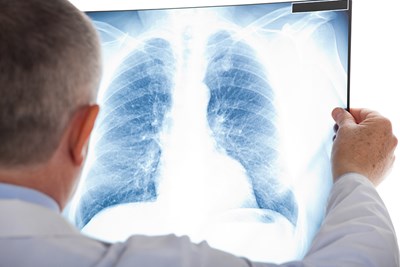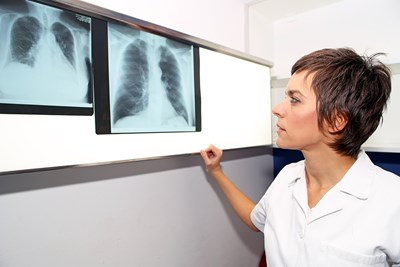A pulmonary embolism (PE) is a clot that has formed and then traveled through the circulatory system to lodge in the blood vessels of the lungs. Deep vein thrombosis (DVT) is a primary cause of pulmonary embolisms, but the presence of certain things in clots, as well as certain risk factors, can all impact the development of this condition. Here’s a look at how embolisms form, as well as the causes and risk factors of PE.
Understanding Embolisms, Thrombosis, and Thromboembolisms
Clotting is the body’s natural response to recovering from wounds. Certain factors within the blood help platelets “clot” together at the site of a wound, minimizing bleeding. A blood clot, or thrombus, can form incorrectly from this reaction by the body. Thrombi can cause larger issues rather than provide help to stop bleeding.
Although tumors, air vessels, and other bits from the body can create blood clots, most often thrombi are a gelatinous clump of fibrin, platelets, and thick plasma. The body can, but doesn’t always, naturally dissolve clots, largely with the help of a substance called “D-dimer.” When it doesn’t, or doesn’t do so fast enough, even clots that are small in relation to the vessel they formed within can be extremely problematic. PE develops most often as a result of a deep vein thrombosis that has become trapped in the very small blood vessels of the lungs.
Deep Vein Thrombosis
Blood clots can be venous or arterial. Because the blood in the veins moves more slowly, clots are more likely to develop there than in arteries. Additionally, pulmonary embolism is more likely to develop as a result of venous clotting. Deep vein thrombosis is a condition in which thrombi develop in the veins deep inside the muscles of the legs. When clots break loose from these larger veins, they travel into the heart and lungs. In the lungs, they can cut off the flow of blood that carries fresh oxygen to the rest of the body and the disposal of carbon dioxide waste. It also causes damage to the part of the lung in which the clot is located. Pulmonary infarction refers to this loss of blood that leads to deadened areas of the lung. Generally, multiple clots end up in the lungs, although they may not all show up at once.
Pulmonary Embolism Risk Factors
Among the many other things that can contribute to pulmonary embolism are certain medical conditions, medical procedures, and immobility. Obesity and smoking cigarettes may also contribute to the development of thrombi. In addition to DVT, individuals with cardiovascular disease are at an increased risk of developing PE. The presence of a cardiovascular disease suggests there is already an issue with the heart, lungs, or blood vessels, making it that much easier for a thrombus to cause problems in the lungs. Furthermore, certain inherited disorders can place you at an increased risk for clotting. Factor V Leiden is a genetic disorder in which an excess of clotting factors results in easier clotting.
Being pregnant can increase the risk of clotting for women. Again, clotting is more likely in slower moving blood vessels. The weight of the fetus resting on the lower abdomen can make stagnant blood even slower. Pregnant women with additional or genetic risks are often recommended to high-risk obstetricians.
Procedures that may increase clotting include some cancer treatments and surgical procedures. Some types of cancer can actually interfere with your body’s natural clotting system, while chemotherapy can increase the risk of clotting, as well. Estrogen therapies may also be problematic. Supplemental estrogen, whether from birth control or replacement therapy, may increase certain clotting factors, particularly if other risk factors are already at play. Surgery is also a major contributor to thrombosis, particularly because it generally requires less activity in the weeks following the procedure. Immobility as a result of long trips or a sedentary lifestyle can also promote inappropriate clotting.




